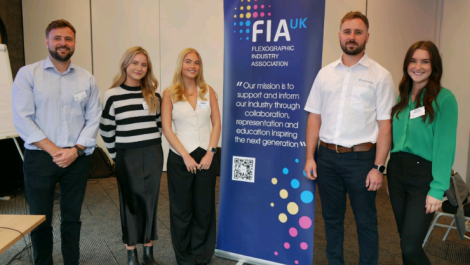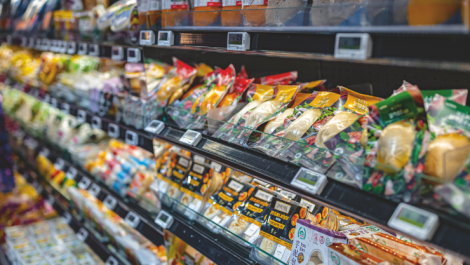The annual UK user conference held by Esko at Loughborough University gave attendees details of the latest updates and a chance to meet the experts, ask questions and get their hands on the specialised software. Neel Madsen took a seat in the lecture hall.
With nearly 200 attendees filling the lecture hall, Paul Bates, UK and Eire business manager, welcomed the audience to the famous university, which as he pointed out sent no fewer than 70 athletes to the Olympics Games in London this summer.
The conference covered three main areas: the digital display and finishing market, which Mr Bates described as a ‘huge developing market for us’, brand management and Solution Services, which covers training, customer support, consulting and systems integration teams.
He explained that Esko has its roots in Danish company Purup Eskofot A/S, which was established through a merger in 1996, and that today, the company is part of Danaher’s portfolio of industrial technologies alongside X-rite Pantone. He said, ‘This is a fantastic marriage for us. For years, Esko has dabbled in colour, today we are in the colour business.’
The morning’s plenary sessions consisted of ‘What’s new?’ presentations on the company’s main products, including Automation Engine (AE), WebCenter, Editors and Solution Architects.
Product manager, Dries Vandenbussche, said that the company is working on improving the ease of deployment of AE. This will be done as webstyle updating so that the server update will automatically update all clients too. New tools include scripting viewer improvements and link with WebCenter.
Jijo Dominic, product manager, said that with the latest updates and new tools, WebCenter has evolved from an online approval solution to a true packaging management solution. Its dedicated copy management module promises to reduce the disproportionately large amount of time of the production process spent on the copy.
Dan Pulling and Rafiq Mulla presented a detailed account of PantoneLive, the cloud-based online colour database, which is a collaboration between Esko and X-rite. Implementing this technology should, they said, remove all the mismatched expectations to colour reproduction throughout the value chain and it enables printers to target an achievable goal.
Under the topic ‘What’s new in Editors’, director Frank Adegeest presented the interactive pre-media applications roadmap both in the short and long term. Kris Van Bael then gave a demonstration of how quick and easy it is to build a virtual store using Vizualiser.
The conference was supported by a number of partner companies, including X-rite and Label Traxx. Roland DG demonstrated the digital packaging prototyping capabilities of its VersaCamm VS-420 and VersaUV LEC-330 wide format inkjet print and cut devices. The Quick Brown Fox GmbH presented its Aramis MIS and Portos web portal systems, which integrate with Automation Engine and WebCenter, while wide format distributor Digital Print Innovations also had a stand. The European Flexographic Industry Association was present along with LearningAid, which has developed the Academy 2 online training resource.
In the afternoon, the conference was divided into four streams aimed at different user groups: pre-press workflow, sign & display, flexo imaging and CAD. Within each section, a number of presentations were run in parallel and users had the options of mixing and matching these according to their interests.
Quality jump
For flexo imaging users, Pascal Thomas, business development manager, digital flexo EMEA, looked at the market trends in flexo supported by figures from Smithers Pira. Although true labels may be slowing down as printers move into new areas, there is still growth in flexo with particularly shrink sleeves, banners and pouches offering new opportunities. For flexible packaging, the motivation is reducing costs and shortening run lengths while corrugated is experiencing a significant move from offset to flexo.
With HD Flexo present in all packaging arenas, new Esko developments include Pixel+, an innovation which enhances partnering flat top dot technologies from DuPont, MacDermid and Flint, by increasing solid ink density, reducing dot bridging and improving highlights.
At drupa, Esko introduced a technology preview of Full HD Flexo, which combines HD Flexo with Inline UV 2 main exposure. It promises what Mr Thomas describes as ‘a leap forward in flexo printing quality’ and it is the company’s answer to the problem of producing excellent highlights and gravure-like sold ink densities from the same plate.
Bermuda triangle
Dan Pulling, business development manager, HD Flexo and Color, presented fixed palette printing as the answer to the need to reduce costs in flexo printing. The interplay between shelf impact, brand consistency and the need to reduce costs and time to market is the Bermuda Triangle of packaging.
With a massive 70% of new products failing, profit for the brand owner has to come from the remaining 30%. Shelf impact is therefore of enormous importance. Colour is the number one brand asset and it has to be consistent across all packaging elements, however, trials have also shown that when faced with the potential cost savings that fixed palette printing can offer, most brand owners will choose the cheaper option even if compromises have to be made or designs changed.
Mr Pulling gave several real life examples of customers which had chosen this solution. Fixing the number of colours used on press to seven, reduced printing costs for one major US brand owner by a massive $40 million in one year. All its designs are now done in flexo and its presses only stopped once a month for washdown of the inks.
Automating the plate room
Another presentation from Mr Pascal covered the Digital Flexo Suite (DFS) system, which is now in operation at more than 150 facilities worldwide.
Mr Pascal explained that automating plate cutting by using a Kongsberg cutting table as part of the workflow offers a 10% reduction in waste on plate material and ancillaries such as solvent or fleece as well as recycling costs. Another cost saving device is the ‘micro cross’ – a non printing mounting mark which replaces the microdots on the plate. This can be placed inside the image on the floor of the plate and in turn the size of the plate can be reduced.
For labels, Esko has done a case study in collaboration with Wink and Gallus of the benefits of staggering images on the plate. This has shown to reduce bounce and cutting noise by 75%. Further as image distance can be as little as 2 mm less substrate is used.
For corrugated, the machine accuracy of DFS leads to a uniform appearance of the carrier with the option to bevel cut ‘slugs’ to improve glue contact and cutting off the corners reducing the chance of peeling.
Colour retouching
The final flexo related talk was given by Kris van Bael, product manager for 3D and retouching. For package image retouching using PhotoShop, Esko has Equinox for multi-colour (fixed palette) printing, Ink Tools for working with spot colours and Flexo Tools for retouching flexo images. Mr van Bael said, ‘We want to remain active in these sectors and future developments will be updates and plugins for these three products.’
For users following the other three streams, there were in-depth presentations on pre-press workflow and process management, colour management for packaging and multi colour process printing, market trends and driving the workflow in the sign and digital sector, I-cut Suite 12 and ArtiosCAD 12 amongst others.






